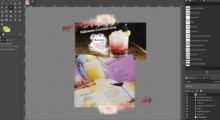A Sad case of regression
This discussion is connected to the gimp-user-list.gnome.org mailing list which is provided by the GIMP developers and not related to gimpusers.com.
This is a read-only list on gimpusers.com so this discussion thread is read-only, too.
| A Sad case of regression | . | 15 Jun 11:29 |
| A Sad case of regression | Renaud OLGIATI | 15 Jun 13:33 |
| A Sad case of regression | Chris Mohler | 15 Jun 18:18 |
| A Sad case of regression | Daniel Smith | 15 Jun 18:25 |
| A Sad case of regression | Stephen Allen | 16 Jun 14:39 |
| GIMP on Thin clients | Gunold Brunbauer | 17 Jun 10:50 |
| GIMP on Thin clients | Dominik Tabisz | 17 Jun 13:25 |
| GIMP on Thin clients | Ofnuts | 17 Jun 22:03 |
A Sad case of regression
From: Helen
I work with agents for my art galleries. One of my agents wants everything sent as jpeg so I send her what she wants.
One wants .tif so I send her what she wants. Juried exhibits ask for jpeg (I don't know why but this change adds hours to a job that should take me half an hour.
I fail to understand why using E rather than S adds any time at all to your work. What's happening in those extra hours?
Dave Russell London
A Sad case of regression
On Sat, 15 Jun 2013 12:29:37 +0100 "." wrote:
I fail to understand why using E rather than S adds any time at all to your work.
Not the time, but the annoyance at the stupidity of being told my file has not been saved, when I have just saved it back to its original format through Export.
Cheers,
Ron.
Nothing is always absolutely so.
-- Theodore Sturgeon
-- http://www.olgiati-in-paraguay.org --
A Sad case of regression
On Sat, Jun 15, 2013 at 8:33 AM, Renaud OLGIATI wrote:
I fail to understand why using E rather than S adds any time at all to your work.
Not the time, but the annoyance at the stupidity of being told my file has not been saved, when I have just saved it back to its original format through Export.
See, now this I don't get. Instead of the dialog in 2.6 that was "You can't include layers, paths, etc. in JPEG, flatten image?", now there's a dialog that's "Hey you might have exported but you didn't save your layers, paths, etc, save them?" - and somehow this is so vastly different?
I was against the current behavior at the beginning, but my GIMP work falls into one of two cases and it works out this way:
1.) "Without a net" - destructive editing
- I need to edit something like a 1-bit TIFF or a greyscale PNG.
- The file is already the result of export from a complex vector file.
- And all I really need to do is make some bits black, or some bits white.
- Most of the time, I don't use layers or masks - if it's getting
too complex I need to go back to the vector source and correct there,
then do another export.
- So, I open, edit, export, close the file - and then I get the
warning, at which point I pause for a second and think: "did I add
layers, masks, etc. that I need in case this file is a tiny bit off?".
99% of the time, I just close without saving - but there is that tiny
percent left where I think "hmm... I did save that really complex
selection that might come in handy - what the hell, I'll save it."
So in case #1, it adds all of a second or maybe three to my workflow and I've become quite used to it. It seems the loudest complaints come from similar workflows - which are not part of GIMP's target. Which brings me to...
2.) "Full-on GIMP" - lossless editing
- I'm creating a layered composition, or a background for another
composition that is layered and/or complex.
- So there's anything from text layers, layer masks, blending
modes - all types of stuff that isn't going to be retained in the
export format.
- I work, save the file as eg "file_20130615-01.xcf". I export in
my target format.
- If the final needs changes (or I've been working over an hour),
I save as "file_20130615-02.xcf", work, save, export.
Case #2 is exactly how I work with everything in Adobe CS - Photoshop, Illustrator, etc. already. Except that eg Illustrator doesn't restrict the "clean" flag to just AI (it will treat PDF and EPS as a cleanly saved format), it's exactly the same behavior. For example if I create a file in AI, save it, make some changes, export PNG, close it - it will warn me that.... wait for it.... I didn't save the changes in a format that will be recognized by Illustrator the next time I open the file. Sounds familiar, no? ;)
Since I already work this way, I never see the "you didn't save" dialog on these types of GIMP projects. At least, if I'm doing it right that is ;) So it adds 0 seconds to my workflow.
I'll give you a simple example of #2: a client sends me a set of bracketed images of a property to combine as "HDR" (never mind that there are plenty of other tools, client also wants the dog poop out of the yard and the windows cleaned while we're at it, eh?). I'm certainly going to consider the file "saved" only when it retains all of my layers and masks, never mind if the client is only going to see the exported JPEG. That way, when they come back and ask "now can we make the sky green?" (stranger requests have been made), it's "open, adjust layer, save as, export, close" instead of "open, make mask (again), adjust, export, close, don't save". Which saves me time, which saves them money, which makes me more valuable as an asset.
If all of your GIMP usage falls into #1, you're probably using the wrong tool for the job. Either deal with the extra dialog, or deploy one of the various workarounds (or use another tool). If you're in #2, the distinction should make no difference at all, really, unless you enjoy doing the same work over and over again.
Chris
PS - we can do without the name-calling and nation-baiting.
A Sad case of regression
well, i gotta say, that were i ever to actually use the gimp in any heavy
capacity, or a company i worked at would, these "saving" lists would be
required reading due to the variety of formats/procedures detailed.
thanks, i guess.
:)
dan
On Sat, Jun 15, 2013 at 1:18 PM, Chris Mohler wrote:
On Sat, Jun 15, 2013 at 8:33 AM, Renaud OLGIATI wrote:
I fail to understand why using E rather than S adds any time at all to your work.
Not the time, but the annoyance at the stupidity of being told my file
has not been saved, when I have just saved it back to its original format through Export.
See, now this I don't get. Instead of the dialog in 2.6 that was "You can't include layers, paths, etc. in JPEG, flatten image?", now there's a dialog that's "Hey you might have exported but you didn't save your layers, paths, etc, save them?" - and somehow this is so vastly different?
I was against the current behavior at the beginning, but my GIMP work falls into one of two cases and it works out this way:
1.) "Without a net" - destructive editing - I need to edit something like a 1-bit TIFF or a greyscale PNG. - The file is already the result of export from a complex vector file. - And all I really need to do is make some bits black, or some bits white.
- Most of the time, I don't use layers or masks - if it's getting too complex I need to go back to the vector source and correct there, then do another export.
- So, I open, edit, export, close the file - and then I get the warning, at which point I pause for a second and think: "did I add layers, masks, etc. that I need in case this file is a tiny bit off?". 99% of the time, I just close without saving - but there is that tiny percent left where I think "hmm... I did save that really complex selection that might come in handy - what the hell, I'll save it."So in case #1, it adds all of a second or maybe three to my workflow and I've become quite used to it. It seems the loudest complaints come from similar workflows - which are not part of GIMP's target. Which brings me to...
2.) "Full-on GIMP" - lossless editing - I'm creating a layered composition, or a background for another composition that is layered and/or complex. - So there's anything from text layers, layer masks, blending modes - all types of stuff that isn't going to be retained in the export format.
- I work, save the file as eg "file_20130615-01.xcf". I export in my target format.
- If the final needs changes (or I've been working over an hour), I save as "file_20130615-02.xcf", work, save, export.Case #2 is exactly how I work with everything in Adobe CS - Photoshop, Illustrator, etc. already. Except that eg Illustrator doesn't restrict the "clean" flag to just AI (it will treat PDF and EPS as a cleanly saved format), it's exactly the same behavior. For example if I create a file in AI, save it, make some changes, export PNG, close it - it will warn me that.... wait for it.... I didn't save the changes in a format that will be recognized by Illustrator the next time I open the file. Sounds familiar, no? ;)
Since I already work this way, I never see the "you didn't save" dialog on these types of GIMP projects. At least, if I'm doing it right that is ;) So it adds 0 seconds to my workflow.
I'll give you a simple example of #2: a client sends me a set of bracketed images of a property to combine as "HDR" (never mind that there are plenty of other tools, client also wants the dog poop out of the yard and the windows cleaned while we're at it, eh?). I'm certainly going to consider the file "saved" only when it retains all of my layers and masks, never mind if the client is only going to see the exported JPEG. That way, when they come back and ask "now can we make the sky green?" (stranger requests have been made), it's "open, adjust layer, save as, export, close" instead of "open, make mask (again), adjust, export, close, don't save". Which saves me time, which saves them money, which makes me more valuable as an asset.
If all of your GIMP usage falls into #1, you're probably using the wrong tool for the job. Either deal with the extra dialog, or deploy one of the various workarounds (or use another tool). If you're in #2, the distinction should make no difference at all, really, unless you enjoy doing the same work over and over again.
Chris
PS - we can do without the name-calling and nation-baiting. _______________________________________________ gimp-user-list mailing list
gimp-user-list@gnome.org
https://mail.gnome.org/mailman/listinfo/gimp-user-list
A Sad case of regression
Excellent post sir. Just because one is in software development, doesn' t mean they understand professional image editing workflow.
Yeah I'm looking at a certain Debian developer .... ;-D
Cheers, Stephen, Toronto My Google+ Profile | http://goo.gl/JbQsq
GIMP on Thin clients
I`m a network administrator in a secondary school.
In our computer network we have 15 thin clients.
Ive installed GIMP and it worked fine. But when the pupils start gimp,
then there are always some workstations on which gimp ist very, very slowly.
I suppose, that those thin clients on which gimp ist started last wont
get enough memory.
How can I achieve that gimp will use only a limitede amount of memory space?
Thank you for your advice
Gunold
GIMP on Thin clients
Try Edit>Preferences>Enviroment (it's the first card in dialog box)
There You'll control maximum size of image, size of cache etc.
In theory there is another solution - Xprograms can be run on one machine and displayed on another. This was philosophy behind Xserver and Xclient but i've never heared about anybody running GIMP this way.
Good Luck Dominik
2013/6/17, Gunold Brunbauer :
I`m a network administrator in a secondary school. In our computer network we have 15 thin clients. I´ve installed GIMP and it worked fine. But when the pupils start gimp, then there are always some workstations on which gimp ist very, very slowly.
I suppose, that those thin clients on which gimp ist started last wont get enough memory.
How can I achieve that gimp will use only a limitede amount of memory space?
Thank you for your advice
Gunold
_______________________________________________ gimp-user-list mailing list
List address: gimp-user-list@gnome.org List membership: https://mail.gnome.org/mailman/listinfo/gimp-user-list
Dominik Tabisz
GIMP on Thin clients
On 06/17/2013 12:50 PM, Gunold Brunbauer wrote:
I`m a network administrator in a secondary school. In our computer network we have 15 thin clients. Ive installed GIMP and it worked fine. But when the pupils start gimp, then there are always some workstations on which gimp ist very, very slowly.
I suppose, that those thin clients on which gimp ist started last wont get enough memory.
How can I achieve that gimp will use only a limitede amount of memory space?
Thank you for your advice
Gunold
If Gimp is slowed down by memory issues in startup, I don't see how you can realistically expect to use it with real images that will quickly require a couple of hundred megabytes. After startup, with no images, my 64-bit Linux Gimp uses 60MB or memory (+ 20MB shared) but even simple image quickly double this.
Starting Gimp also implies some file activity, so you have some I/O contention instead. What are the slow machines displaying when they limp along? loading plugins? checking fonts?











